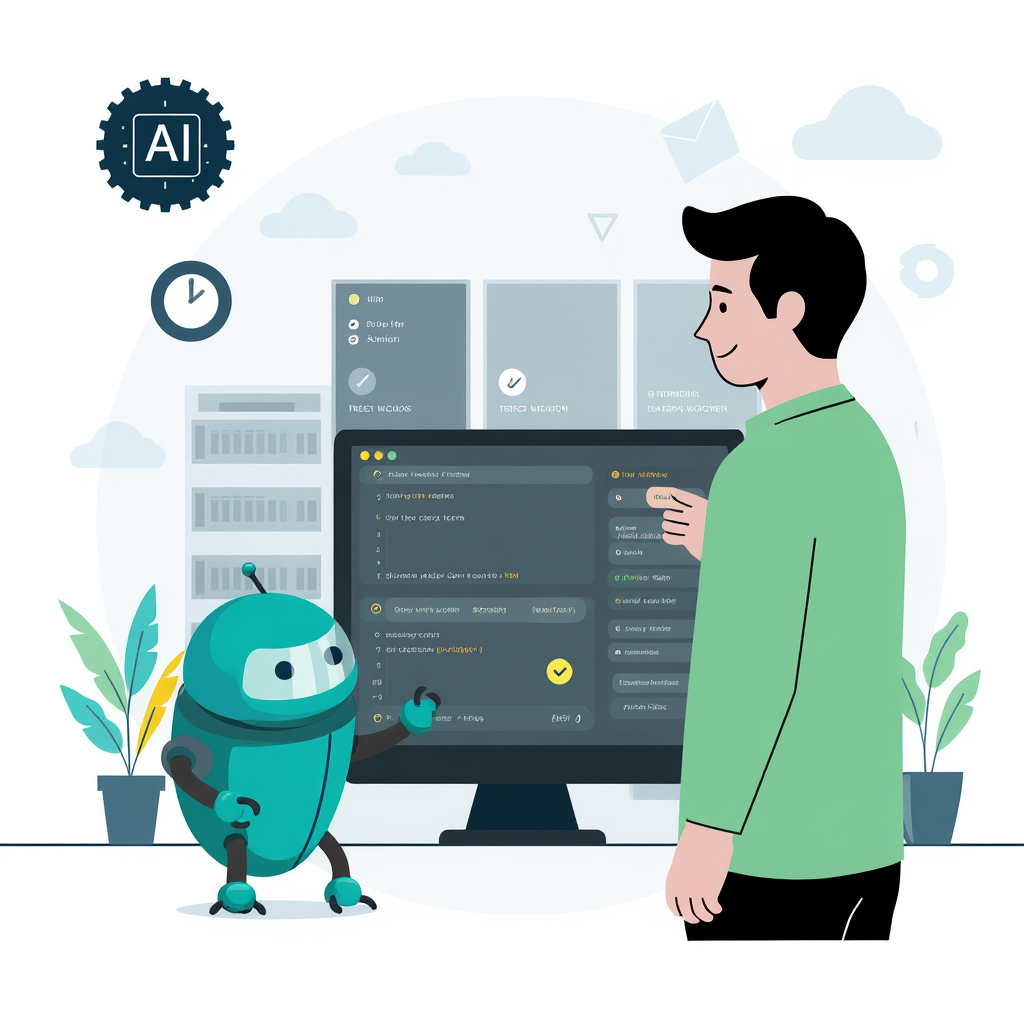Traditional technical debt migration requires months of developer effort and carries significant risk of introducing bugs. Yet Airbnb revolutionised this process by leveraging Large Language Models against legacy code, achieving a 97% success rate in automated test migrations.
Their counter-intuitive approach—embracing retry loops and failure-based learning instead of perfect upfront prompting—reduced years of manual work into weeks of systematic automation. By scaling context windows to 100,000 tokens and implementing iterative refinement, they transformed migration from a resource-intensive burden to a strategic advantage.
How does Airbnb’s retry loop approach outperform perfect upfront prompting for AI code migration?
Airbnb discovered that allowing LLMs to fail and retry with improved context delivers higher success rates than attempting perfect initial prompts. Their retry loops analyse failure patterns, adjust prompts dynamically, and iterate until successful migration, achieving 97% accuracy compared to 75% with static prompting approaches.
Instead of obsessing over crafting the perfect initial prompt, Airbnb’s team adopted a pragmatic solution: automated retries with incremental context updates. Each failed step triggers the system to feed the LLM the latest version of the file alongside validation errors from the previous attempt.
This dynamic prompting approach allows the model to refine its output based on concrete failures, not just static instructions. The retry mechanism runs inside a configurable loop runner, attempting each operation up to ten times before escalating to manual intervention. Most files succeed within the first few retries, with the system learning from each failure to improve subsequent attempts.
How do 100,000-token context windows enable complex architectural understanding in code migration?
Extended context windows allow LLMs to process entire file hierarchies, dependency graphs, and architectural patterns simultaneously. This comprehensive understanding enables more accurate migration decisions by considering how changes affect related components, imports, and testing patterns across the codebase.
The breakthrough came from recognising that adding more tokens didn’t help unless those tokens carried meaningful, relevant information. The key insight was choosing the right context files, pulling in examples that matched the structure and logic of the file being migrated.
Airbnb’s prompts expanded to anywhere between 40,000 to 100,000 tokens, pulling in as many as 50 related files. Each prompt included the source code of the component under test, the test file being migrated, validation failures for the current step, related tests from the same directory to maintain team-specific patterns, and general migration guidelines with common solutions.
Unlike traditional search-and-replace tools, LLMs can comprehend the broader context of a codebase. This approach bridged the final complexity gap, especially in files that reused abstractions, mocked behaviour indirectly, or followed non-standard test setups.
What makes technical debt migration ideal for AI automation compared to manual refactoring?
Technical debt migration involves repetitive patterns, well-defined rules, and clear success criteria—perfect conditions for AI automation. Unlike creative coding, migration follows established transformation patterns that LLMs can learn and apply consistently across thousands of files.
Traditional migrations require extensive manual effort to maintain code quality, ensure compatibility, and handle complex refactoring. Airbnb’s test migration exemplifies this challenge. Manually refactoring each test file was expected to take 1.5 years of engineering time, requiring developers to update thousands of lines of code while ensuring no loss in test coverage.
LLMs excel at this type of work because they can handle bulk code modifications—updating function signatures, modifying API calls, and restructuring legacy patterns. The automation enables parallel processing of hundreds of files simultaneously, transforming sequential manual work into concurrent operations.
How does Airbnb’s step-based workflow manage complex migration validation and rollback?
The step-based workflow breaks migration into discrete, validatable stages with automated checkpoints. Each step includes validation tests, rollback procedures, and progress tracking, enabling safe parallel processing while maintaining code quality and system stability throughout the migration process.
To scale migration reliably, the team treated each test file as an independent unit moving through a step-based state machine. They modelled this flow like a state machine, moving the file to the next state only after validation on the previous state passed.
The key stages included Enzyme refactor, Jest fixes, lint and TypeScript checks, and final validation. State transitions made progress measurable—every file had a clear status and history across the pipeline. Failures were contained and explainable; a failed lint check didn’t block the entire process, just the specific step for that file.
Each file was automatically stamped with a machine-readable comment that recorded its migration progress. A CLI tool allowed engineers to reprocess subsets of files filtered by failure step and path pattern, making it simple to focus on fixes without rerunning the full pipeline.
Why does iterative refinement achieve higher success rates than single-pass AI migration?
Iterative refinement allows the system to learn from edge cases and failure patterns, continuously improving prompt effectiveness and handling complex scenarios. This approach moved Airbnb from 75% to 97% success rates by systematically addressing categories of failures rather than attempting perfect first attempts.
The team performed breadth-first prompt tuning for the long tail of complex files. To convert failure patterns into working migrations, they used a tight iterative loop: sample 5 to 10 failing files with a shared issue, tune prompts to address the root cause, test against the sample, sweep across all similar failing files, then repeat the cycle with the next failure category.
In practice, this method pushed the migration from 75% to 97% completion in just four days. The first bulk migration pass handled 75% of the test files in under four hours, providing a solid foundation. For the remaining files, the system had already done most of the work; LLM outputs served as solid baselines rather than final solutions.
What are the key components of an LLM-driven code migration pipeline for your team?
An effective LLM migration pipeline requires four core components: intelligent context injection, dynamic prompting systems, automated validation frameworks, and systematic rollback capabilities. Your team can implement this architecture incrementally, starting with simple transformations and scaling complexity as confidence grows.
Google’s research identifies three conceptual stages: targeting locations, edit generation and validation, and change review and rollout. Each migration requires as input a set of files and locations of expected changes, one or two prompts that describe the change, and optional few-shot examples.
The pipeline architecture centres on autonomous operation with human oversight. The migration toolkit runs autonomously and produces verified changes that only contain code passing unit testing. Each failed validation step can optionally run ML-powered repair, creating self-healing capabilities within the system.
For resource-constrained teams, implementation follows a phased approach. Start with simple, low-risk migrations to build confidence and understanding. Integrate with existing CI/CD pipeline infrastructure to leverage current tooling investments.
How do you handle edge cases and manual intervention in automated AI migration?
Airbnb’s approach identifies edge cases through systematic failure analysis, then applies targeted manual intervention for complex files while maintaining automation for standard patterns. This hybrid approach ensures comprehensive migration while optimising resource allocation between automated and human effort.
Agents flag migrations where token confidence scores, code diff coverage, or structural completeness fall below threshold, creating clear criteria for escalation to manual review.
The remaining files, representing the final 3%, were resolved manually using LLM-generated outputs as starting points. These files were too complex for basic retries and too inconsistent for generic fixes. However, the LLM outputs provided valuable scaffolding, reducing manual effort compared to starting from scratch.
The hybrid workflow design enables developers to step in at flagged points, review the agent’s suggestions, and manually edit or approve before committing code. This prevents propagating errors through the codebase while maintaining systematic progress.
What ROI metrics should you track when implementing AI-assisted technical debt reduction?
Key metrics include migration velocity (files per week), success rate percentages, developer time savings, and defect reduction rates. You should also track implementation costs, team adoption rates, and long-term maintenance burden reduction to demonstrate clear business value from AI automation investments.
The most effective approach is defining what engineering performance means for your organisation and deciding on specific metrics to measure AI impact on that performance. Research shows that developers on teams with high AI adoption complete 21% more tasks and merge 98% more pull requests, demonstrating measurable productivity improvements.
Critical AI testing metrics include time-to-release reduction, test coverage increases, maintenance effort reduction, defect detection improvement, and resource utilisation shifts. However, tracking reveals important bottlenecks: PR review time increases 91%, revealing human approval as a critical constraint that must be addressed systematically.
The financial benefits become clear quickly. Airbnb’s migration was completed in six weeks with only six engineers involved, representing dramatic resource efficiency compared to traditional approaches.
Conclusion
Airbnb’s approach demonstrates that technical debt migration doesn’t have to be a resource-intensive burden that teams postpone indefinitely. By embracing failure-based learning, scaling context windows intelligently, and implementing systematic validation, they transformed a 1.5-year manual project into a six-week automated success.
The methodology’s power lies in its counter-intuitive embrace of failure as a learning mechanism. Rather than pursuing perfect upfront prompting, the retry loop system learns from mistakes, continuously improving success rates through systematic iteration.
For teams facing similar challenges, the implementation path is clear: start with high-impact, low-complexity migrations to build confidence, invest in comprehensive validation systems, and gradually scale complexity as team capabilities grow. The ROI appears quickly, with most teams achieving positive returns within 3-6 months while dramatically reducing maintenance burden and improving development velocity.












